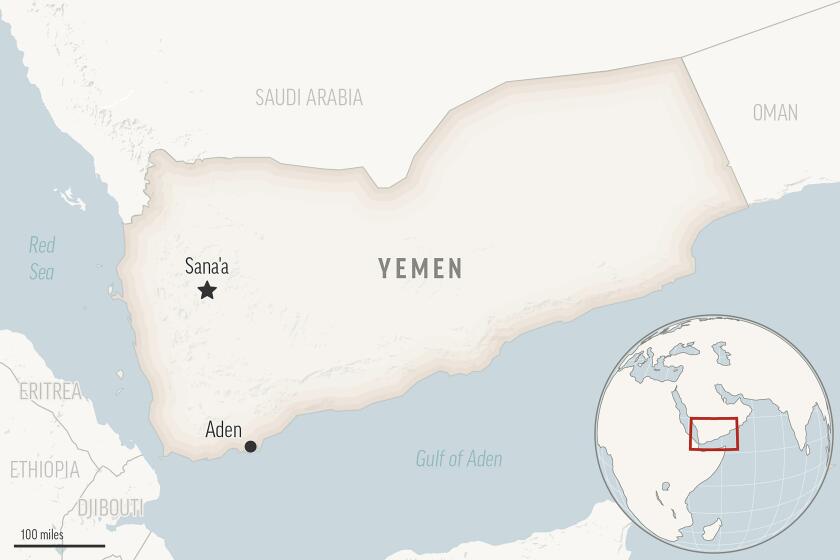‘Star Wars’ Chemical Laser Is Unveiled : Research: Weapon would try to destroy missiles in space. Tour coincides with funding battle in Congress.
- Share via
SAN JUAN CAPISTRANO — For the first time, the Department of Defense on Saturday allowed news media to view the gigantic Alpha chemical laser that represents the second line of the nation’s “Star Wars” defense against ballistic missile attack.
The public unveiling of the TRW facility here follows two tests indicating that the laser can produce more than a megawatt (1 million watts) of power, enough to destroy enemy missiles while they are in the first stages of their launch.
TRW officials say the first weapons could be deployed around the turn of the century. Its primary role would be to back up the so-called kinetic energy systems, such as “Brilliant Pebbles,” in which projectiles would be smashed into missiles and warheads to destroy them.
The laser device works by concentrating massive heat on its target, burning a hole through it and causing it to explode. A megawatt laser, said Joseph Miller of TRW, produces heat that is several times more intense than that produced in the throat of the rocket engines on the space shuttle. Such heat will burn through most materials, even those that are highly reflective.
Initially, the chemical laser system, operating from orbit, might be used to discriminate between real warheads and decoys, perhaps destroying the decoys and heating up the warheads so they can more readily be targeted by the kinetic energy weapons, said Dan Wildt of the Strategic Defense Initiative Organization.
Eventually, it might become the primary line of defense. By operating at the speed of light, lasers can destroy missiles shortly after launch so that debris falls on the territory of the aggressor. That is particularly important, Wildt said, if the warhead contains chemical or biological weapons.
Had the system been operational during the Persian Gulf War, it could have “unquestionably” shot down the Scud missiles launched by Iraq, said Neil Griff of the SDIO.
The first press tour of the San Juan Capistrano facility came nearly two years after the site was visited by Soviet arms experts. That visit was organized to demonstrate that “there were no surprises” in the Star Wars program, Griff said.
He also noted that it was “coincidental” that the briefing was arranged when Congress was debating funding for SDIO.
The $250-million Alpha laser is by far the most powerful yet produced. Unlike most lasers in use, which are powered by electricity, Alpha is powered by a chemical reaction, the combination of gaseous hydrogen and fluorine to produce hydrogen fluoride. That chemical reaction produces enormous amounts of power, allowing the device to have a power source small enough to be lofted into space.
The lightweight aluminum Alpha laser, under development since the early 1980s, has been fired seven times, for periods ranging from a fifth of a second to 4.6 seconds for the most recent test, conducted May 16. For antimissile defense, the device would have to operate continuously for several minutes.
Alpha alone is not powerful enough to destroy enemy missiles from space, but it can easily be made more powerful by making it larger, TRW’s Miller said.
Although TRW scientists will continue test-firing the laser, the next major step will be the installation here of a high-precision mirror that would focus the laser beam on targets. “We’ve come quite a distance and we’re ready for the next step,” Miller said.
Those tests are scheduled to begin in 1994 and, if successful, would be followed two to four years later by the first test of the combined laser-mirror system in space, a project expected to cost about $1.5 billion.
Deployment of the lasers could begin three to five years after that. An operational system would be composed of “several 10s” of lasers produced at a cost of hundreds of millions of dollars apiece, Griff said. Each antimissile laser platform would weigh as much as 200,000 pounds, and their deployment may be dependent upon the success of the heavy launch vehicle being developed.
Critics of the laser system, such as John Pike of the Federation of American Scientists, have argued that mating the chemical laser to its aiming system will provide a formidable challenge. Some have also charged that testing it in space would represent a violation of the 1972 Antiballistic Missile Treaty.
Griff said that the laser to be tested in space will have its power reduced and its aiming ability severely limited so that it will not violate the treaty.
More to Read
Sign up for Essential California
The most important California stories and recommendations in your inbox every morning.
You may occasionally receive promotional content from the Los Angeles Times.











